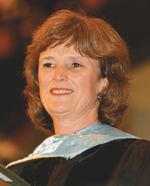Q&A with McLaughlin on the new School of Ed
 Construction for the new School of Education building is well underway at the Monticello entrance to campus. The new facility will bring all of the SOE’s programs together under one roof. Dean Virginia McLaughlin, who was recently appointed to the State Board of Education, talked with William & Mary News about the new facility and what it will mean for the school and the Commonwealth. - Ed.
Construction for the new School of Education building is well underway at the Monticello entrance to campus. The new facility will bring all of the SOE’s programs together under one roof. Dean Virginia McLaughlin, who was recently appointed to the State Board of Education, talked with William & Mary News about the new facility and what it will mean for the school and the Commonwealth. - Ed.
Q. How will the new facility benefit both the College and Virginia?
A. Education students, faculty, and staff are not the only ones who will benefit from this new facility. A hallmark of this School of Education has been a deep commitment to outreach programs, and the new building will help us to serve children, families, practicing professionals, and the public even more effectively. Consider, for example, the New Horizons Family Counseling Center. Despite being headquartered in a tiny suite of cubicles on the second floor of Jones Hall originally assigned to graduate assistants, the program has been providing free counseling services to over 200 families a year. In the new building, this program will finally have the clinic space that it deserves, space easily accessible to families and well-designed for supervision of counselors in training. Similarly, our internationally renowned Center for Gifted Education, which for over 20 years has provided Saturday and Summer Enrichment Programs to children aged four through 16, will now have appropriate space for the 900 children who participate each year. Particularly exciting are our plans for a professional development center within the new facility. The School of Education offers a full calendar of conferences, workshops, and symposia that draw local, state, national, and international participants. As many as 20,000 practicing educators are served each year through our training and technical assistance activities.
Not surprisingly, the prospect of a new facility has stimulated creative ideas for new initiatives being actively explored through School of Education strategic planning.
Q: What will the new facility allow you to do that maybe wasn’t possible before?
A. The new building will include approximately 112,000 square feet of space designed specifically to accommodate Education programs. With roughly 150 undergraduate, 500 masters, and 150 doctoral students, the School of Education facility will be in active use from morning to night year round. New classrooms and labs will enable faculty to model emerging instructional strategies and technologies. Our Learning Resource Center will provide sufficient space and technology support for innovative curriculum development projects. Throughout the building, other spaces will invite collaboration among students and faculty—a critical aspect of acculturation into the Education profession.
Q: How will the new facility impact the SOE’s ability to procure grants?
A. Requests for Proposals issued by governmental agencies or foundations typically require evidence of our capacity to implement the proposed project in a cost-effective manner. Education projects tend to be labor intensive, so we need to able to house the additional people who will work on the new initiative. About a decade ago, we simply ran out of space in Jones Hall. Four of our large projects are currently leasing office space in the Williamsburg community. The new facility includes space for existing centers and projects, as well as more flexible space for future initiatives. By bringing all of our centers and projects under one roof, our students and faculty will have easy access to the additional staff, resources, and opportunities supported through $5 to $8 million of external grants and contracts each year.















